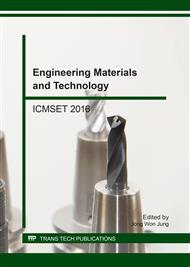[1]
R. J. Moon, A. Martini, J. Nairn, J. Simonsen, J. Youngblood, Cellulose nanomaterials review: structure, properties and nanocomposites, Chem. Soc. Rev. 40(7) (2011) 3941-3994.
DOI: 10.1039/c0cs00108b
Google Scholar
[2]
C. Stevens, J. Müssig, Industrial applications of natural fibres: structure, properties and technical applications, vol. 10. John Wiley & Sons, (2010).
Google Scholar
[3]
G. A. Smook, Handbook for Pulp & Paper Technologists, 3rd edition, Angus Wilde Publications, Inc., (2002).
Google Scholar
[4]
S. Kalia, A. Dufresne, B. M. Cherian, B. S. Kaith, L. Rous, J. Njuguna, E. Nassiopoulos, Cellulose-Based Bio- and Nanocomposites: A Review, Int. J. Polym. Sci., 2011 (2011).
DOI: 10.1155/2011/837875
Google Scholar
[5]
K. Nelson, T. Retsina, M. Iakovlev, A. van Heiningen, Y. Deng, J. A. Shatkin, A. Mulyadi, American Process: Production of Low Cost Nanocellulose for Renewable, Adv. Mater. Appl. Mater. Res. Manuf. Springer, 224 (2016) 267-302.
DOI: 10.1007/978-3-319-23419-9_9
Google Scholar
[6]
A. Dufresne, Nanocellulose: a new ageless bionanomaterial, Mater. Today, 16(6) (2013) 220-227.
DOI: 10.1016/j.mattod.2013.06.004
Google Scholar
[7]
M. Borůvka, P. Lenfeld, Extraction of cellulose nanocrystals as a potential reinforcing material for poly(lactic acid) biocomposites, NANOCON 2015 - 7th International Conference on Nanomaterials - Research and Application, Conference Proceedings, (2015).
Google Scholar
[8]
M. Z. Rong, M. Q. Zhang, Y. Liu, G. C. Yang, H. M. Zeng, The effect of fiber treatment on the mechanical properties of unidirectional sisal-reinforced epoxy composites, Compos. Sci. Technol. 61(10) (2001) 1437-1447.
DOI: 10.1016/s0266-3538(01)00046-x
Google Scholar
[9]
S. Kalia, B. Kaith, I. Kaur, Cellulose fibers: bio-and nano-polymer composites: green chemistry and technology, Springer, (2011).
DOI: 10.1007/978-3-642-17370-7
Google Scholar
[10]
M. Ago, K. Okajima, J. E. Jakes, S. Park, O. J. Rojas, Lignin-based electrospun nanofibers reinforced with cellulose nanocrystals, Biomacromolecules, 13(3) (2012) 918-926.
DOI: 10.1021/bm201828g
Google Scholar
[11]
V. Ugartondo, M. Mitjans, M. P. Vinardell, Comparative antioxidant and cytotoxic effects of lignins from different sources, Bioresour. Technol. 99(14) (2008) 6683-6687.
DOI: 10.1016/j.biortech.2007.11.038
Google Scholar
[12]
J. M. Cruz, J. M. Domínguez, H. Domínguez, J. C. Parajó, Antioxidant and antimicrobial effects of extracts from hydrolysates of lignocellulosic materials, J. Agric. Food Chem. 49(5) (2001) 2459-2464.
DOI: 10.1021/jf001237h
Google Scholar
[13]
K. Toh, S. Nakano, H. Yokoyama, K. Ebe, K. Gotoh, H. Noda, Anti-deterioration effect of lignin as an ultraviolet absorbent in polypropylene and polyethylene, Polym. J. 37(8) (2005) 633-635.
DOI: 10.1295/polymj.37.633
Google Scholar
[14]
C. Reti, M. Casetta, S. Duquesne, S. Bourbigot, R. Delobel, Flammability properties of intumescent PLA including starch and lignin, Polym. Adv. Technol. 19(6) (2008) 628-635.
DOI: 10.1002/pat.1130
Google Scholar
[15]
A. Pei, Q. Zhou, L. A. Berglund, Functionalized cellulose nanocrystals as biobased nucleation agents in poly(l-lactide) (PLLA) – Crystallization and mechanical property effects, Compos. Sci. Technol. 70(5) (2010) 815-821.
DOI: 10.1016/j.compscitech.2010.01.018
Google Scholar
[16]
A. K. Mohanty, M. Misra, L. T. Drzal, Natural fibers, biopolymers, and biocomposites, CRC Press, (2005).
DOI: 10.1201/9780203508206.ch1
Google Scholar
[17]
E. Lizundia, J. L. Vilas, L. M. León, Crystallization, structural relaxation and thermal degradation in Poly(l-lactide)/cellulose nanocrystal renewable nanocomposites, Carbohydr. Polym. 123 (2015) 256-265.
DOI: 10.1016/j.carbpol.2015.01.054
Google Scholar
[18]
D. Watkins, M. Nuruddin, M. Hosur, A. Tcherbi-Narteh, S. Jeelani, Extraction and characterization of lignin from different biomass resources, J. Mater. Res. Technol. 4(1) (2015) 26-32.
DOI: 10.1016/j.jmrt.2014.10.009
Google Scholar


